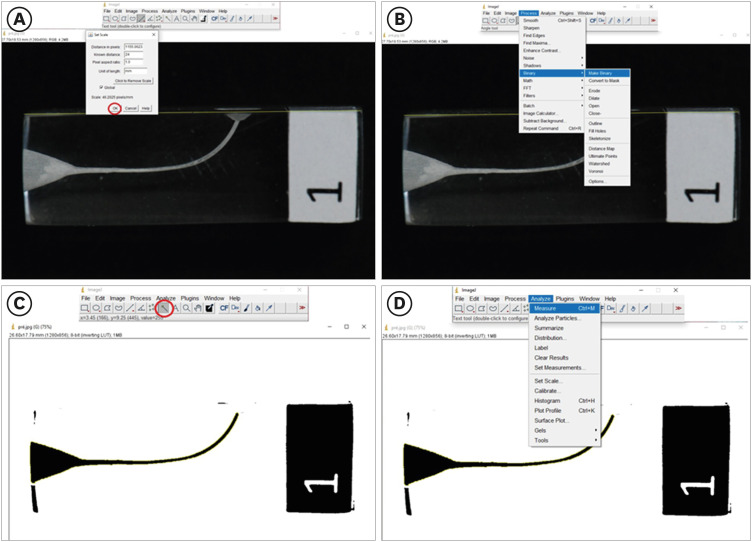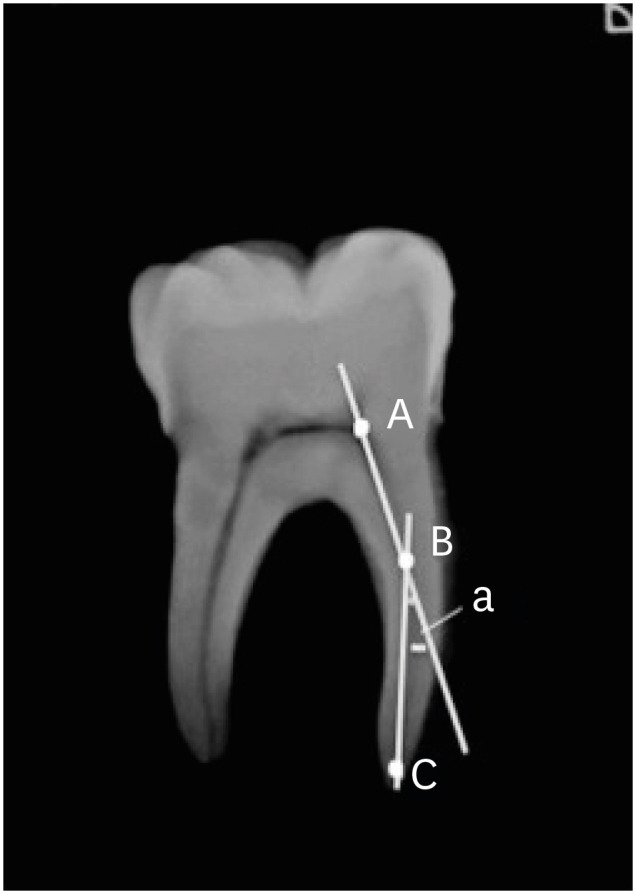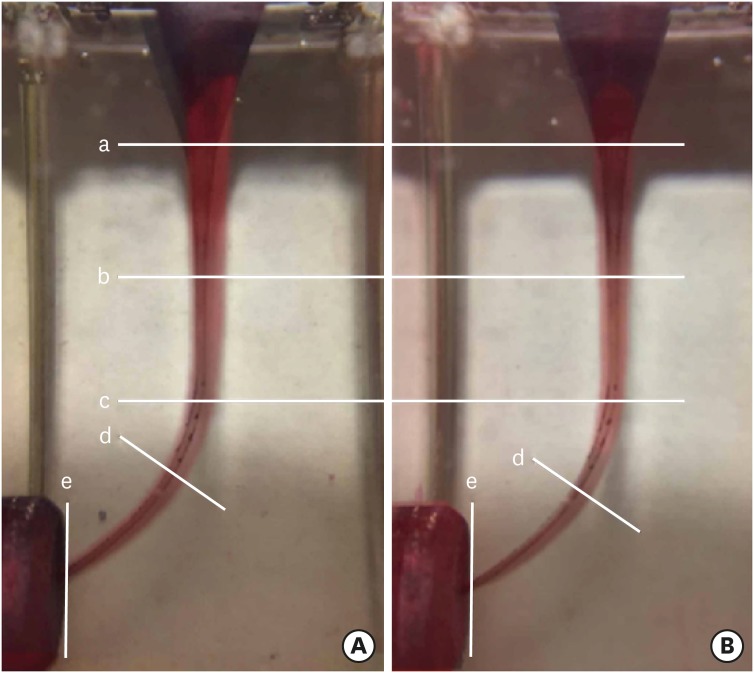Search
- Page Path
- HOME > Search
- Effect of number of uses and sterilization on the instrumented area and resistance of reciprocating instruments
- Victor de Ornelas Peraça, Samantha Rodrigues Xavier, Fabio de Almeida Gomes, Luciane Geanini Pena dos Santos, Erick Miranda Souza, Fernanda Geraldo Pappen
- Restor Dent Endod 2021;46(2):e28. Published online April 29, 2021
- DOI: https://doi.org/10.5395/rde.2021.46.e28

-
 Abstract
Abstract
 PDF
PDF PubReader
PubReader ePub
ePub Objectives This study evaluated the effect of repeated uses and autoclaving in the instrumented area, fracture resistance, and time of instrumentation of thermally treated nickel-titanium reciprocating systems.
Materials and Methods Two hundred simulated canals were instrumented using Reciproc Blue and WaveOne Gold. Each file was used up to 10 times or until fracture. The instrumented area was measured in pre- and post-operative images, using ImageJ software. Kaplan-Meier survival analysis evaluated the number of uses of instruments before fracture. Instrumented area and time of instrumentation were analyzed by Mann-Whitney U test and Kruskal-Wallis. Correlations among the number of uses and instrumented area were measured. The level of statistical significance was set at
p < 0.05.Results Reciproc Blue presented a higher estimated number of uses in comparison with WaveOne Gold (
p = 0.026), but autoclaving did not affect the resistance to fracture of instruments (p > 0.05). The instrumented area was different among the evaluated groups (p = 0.039), and the instrumented area along the uses of both tested instruments was reduced. With the time of instrumentation, there was also a significant difference among the evaluated groups; the groups without sterilization cycles were faster, in comparison to those submitted to autoclaving (p = 0.010).Conclusions Reciproc Blue was more resistant than WaveOne Gold, suffering later fracture. Additionally, the sterilization cycles did not influence the estimated number of uses of thermally treated reciprocating instruments, but the instrumented area of root canals was reduced along with the repeated uses of both instruments.
-
Citations
Citations to this article as recorded by- The influence of autoclave sterilization on the cyclic fatigue of M-wire rotary endodontic instruments
Nenad Stosic, Jelena Popovic, Antonije Stankovic, Aleksandar Mitic, Marija Nikolic, Kosta Todorovic
Vojnosanitetski pregled.2024; 81(10): 642. CrossRef
- The influence of autoclave sterilization on the cyclic fatigue of M-wire rotary endodontic instruments
- 225 View
- 11 Download
- 1 Web of Science
- 1 Crossref

- Effects of the endodontic access cavity on apical debris extrusion during root canal preparation using different single-file systems
- Pelin Tüfenkçi, Koray Yılmaz, Mehmet Adigüzel
- Restor Dent Endod 2020;45(3):e33. Published online June 4, 2020
- DOI: https://doi.org/10.5395/rde.2020.45.e33

-
 Abstract
Abstract
 PDF
PDF PubReader
PubReader ePub
ePub Objectives This study was conducted to evaluate the effects of traditional and contracted endodontic cavity (TEC and CEC) preparation with the use of Reciproc Blue (RPC B) and One Curve (OC) single-file systems on the amount of apical debris extrusion in mandibular first molar root canals.
Materials and Methods Eighty extracted mandibular first molar teeth were randomly assigned to 4 groups (
n = 20) according to the endodontic access cavity shape and the single file system used for root canal preparation (reciprocating motion with the RCP B and rotary motion with the OC): TEC-RPC B, TEC-OC, CEC-RPC B, and CEC-OC. The apically extruded debris during preparation was collected in Eppendorf tubes. The amount of extruded debris was quantified by subtracting the weight of the empty tubes from the weight of the Eppendorf tubes containing the debris. Data were analyzed using 1-way analysis of variance with the Tukeypost hoc test. The level of significance was set atp < 0.05.Results The CEC-RPC B group showed more apical debris extrusion than the TEC-OC and CEC-OC groups (
p < 0.05). There were no statistically significant differences in the amount of apical debris extrusion among the TEC-OC, CEC-OC, and TEC-RPC B groups.Conclusions RPC B caused more apical debris extrusion in the CEC groups than did the OC single-file system. Therefore, it is suggested that the RPC B file should be used carefully in teeth with a CEC.
-
Citations
Citations to this article as recorded by- Comparative Evaluation of Periapical Expulsion Using Manual, Rotary, and Reciprocating Instrumentation With EndoVac Irrigation: An In Vitro Study
Sachin Metkari, Sanpreet S Sachdev, Pravin Patil, Manoj Ramugade, Kishor D Sapkale, Kulvinder S Banga, Dinesh Rao
Cureus.2025;[Epub] CrossRef - Comparison of Debris Extrusion and Preparation Time by Traverse, R‐Motion Glider C, and Other Glide Path Systems in Severely Curved Canals
Taher Al Omari, Layla Hassouneh, Khawlah Albashaireh, Alaa Dkmak, Rami Albanna, Ali Al-Mohammed, Ahmed Jamleh, Lucas da Fonseca Roberti Garcia
International Journal of Dentistry.2025;[Epub] CrossRef - Evaluation of apically extruded debris from root canal filling removal of the mesiobuccal canal of maxillary molars using XP shaper and protaper with two different irrigation
Sanaz Mirsattari, Maryam Zare Jahromi, Masoud Khabiri
Dental Research Journal.2024;[Epub] CrossRef - The Impact of Minimum Invasive Access Cavity Design on the Quality of Instrumentation of Root Canals of Maxillary Molars Using Cone-Beam Computed Tomography: An in Vitro Study
Fahad H Baabdullah, Samia M Elsherief , Rayan A Hawsawi, Hetaf S Redwan
Cureus.2024;[Epub] CrossRef - Assessment of Bacterial Load and Post-Endodontic Pain after One-Visit Root Canal Treatment Using Two Types of Endodontic Access Openings: A Randomized Controlled Clinical Trial
Ahmed M. Al-Ani, Ahmed H. Ali, Garrit Koller
Dentistry Journal.2024; 12(4): 88. CrossRef - The effect of different kinematics on apical debris extrusion with a single-file system
Taher M. N. Al Omari, Giusy Rita Maria La Rosa, Rami Haitham Issa Albanna, Abedelmalek Tabnjh, Flavia Papale, Eugenio Pedullà
Odontology.2023; 111(4): 910. CrossRef - The effects of laser and ultrasonic irrigation activation methods on smear and debris removal in traditional and conservative endodontic access cavities
Hüseyin Gündüz, Esin Özlek
Lasers in Medical Science.2023;[Epub] CrossRef - Influence of access cavity design, sodium hypochlorite formulation and XP‐endo Shaper usage on apical debris extrusion – A laboratory investigation
Jerry Jose, Aishuwariya Thamilselvan, Kavalipurapu Venkata Teja, Giampiero Rossi–Fedele
Australian Endodontic Journal.2023; 49(1): 6. CrossRef - Apically extruded debris, canal transportation, and shaping ability of nickel-titanium instruments on contracted endodontic cavities in molar teeth
Qinqin Zhang, Jingyi Gu, Jiadi Shen, Ming Ma, Ying Lv, Xin Wei
Journal of Oral Science.2023; 65(4): 203. CrossRef - Impact of contracted endodontic cavities on instrumentation efficacy—A systematic review
Manan Shroff, Karkala Venkappa Kishan, Nimisha Shah, Purnima Saklecha
Australian Endodontic Journal.2023; 49(1): 202. CrossRef - Present status and future directions – Minimal endodontic access cavities
Emmanuel João Nogueira Leal Silva, Gustavo De‐Deus, Erick Miranda Souza, Felipe Gonçalves Belladonna, Daniele Moreira Cavalcante, Marco Simões‐Carvalho, Marco Aurélio Versiani
International Endodontic Journal.2022; 55(S3): 531. CrossRef - Effect of guided conservative endodontic access and different file kinematics on debris extrusion in mesial root of the mandibular molars: An in vitro study
Sathish Sundar, Aswathi Varghese, KrithikaJ Datta, Velmurugan Natanasabapathy
Journal of Conservative Dentistry.2022; 25(5): 547. CrossRef - A critical analysis of research methods and experimental models to study apical extrusion of debris and irrigants
Jale Tanalp
International Endodontic Journal.2022; 55(S1): 153. CrossRef - Current strategies for conservative endodontic access cavity preparation techniques—systematic review, meta-analysis, and decision-making protocol
Benoit Ballester, Thomas Giraud, Hany Mohamed Aly Ahmed, Mohamed Shady Nabhan, Frédéric Bukiet, Maud Guivarc’h
Clinical Oral Investigations.2021; 25(11): 6027. CrossRef - Extrusion of debris with and without intentional foraminal enlargement – A systematic review and meta‐analysis
Ricardo Machado, Gislayne Vigarani, Tainara Macoppi, Ajinkya Pawar, Stella Maria Glaci Reinke, Ana Cristina Kovalik Gonçalves
Australian Endodontic Journal.2021; 47(3): 741. CrossRef - Apical debris extrusion of single-file systems in curved canals
Ecehan Hazar, Olcay Özdemir, Mustafa Murat Koçak, Baran Can Sağlam, Sibel Koçak
Endodontology.2021; 33(3): 128. CrossRef - Quantitative Evaluation of Apically Extruded Debris in Root Canals prepared by Single-file Reciprocating and Single File Rotary Instrumentation Systems
Sonal Sinha, Konark Singh, Anju Singh, Swati Priya, Avanindra Kumar, Sahil Kawle
Journal of Pharmacy and Bioallied Sciences.2021; 13(Suppl 2): S1398. CrossRef - THE INFLUENCE OF DIFFERENT PECKING DEPTH ON AMOUNT OF APICALLY EXTRUDED DEBRIS DURING ROOT CANAL PREPARATION
Fatih ÇAKICI, Busra UYSAL, Elif Bahar CAKİCİ, Adem GUNAYDIN
Atatürk Üniversitesi Diş Hekimliği Fakültesi Dergisi.2021; : 1. CrossRef
- Comparative Evaluation of Periapical Expulsion Using Manual, Rotary, and Reciprocating Instrumentation With EndoVac Irrigation: An In Vitro Study
- 353 View
- 7 Download
- 18 Crossref

- Comparison of the ability of Reciproc and Reciproc Blue instruments to reach the full working length with or without glide path preparation
- Mehmet Adıguzel, Pelin Tufenkci
- Restor Dent Endod 2018;43(4):e41. Published online November 1, 2018
- DOI: https://doi.org/10.5395/rde.2018.43.e41
-
 Abstract
Abstract
 PDF
PDF PubReader
PubReader ePub
ePub Objectives The purpose of the present study was to compare the mean preparation times and frequency with which Reciproc and Reciproc Blue instruments reached the full working length in mandibular molars, with or without glide path preparation.
Materials and Methods Previously untreated mesiobuccal and mesiolingual canals with completely formed apices were randomly divided into 6 groups (
n = 50) depending on the usage of Reciproc (RC; VDW), Reciproc Blue (RC Blue; VDW), C-Pilot (CP; VDW), and R-Pilot (RP; VDW) files: RC, RC Blue, RC + C-Pilot (RC-CP), RC-Blue + C-Pilot (RC Blue-CP), RC+R-Pilot (RC-RP), and RC Blue + R-Pilot (RC Blue-RP). A glide path was prepared using the hand-operated C-Pilot or the machine-operated R-Pilot instruments, respectively. The χ2 test, analysis of variance, and the Tukeypost hoc test were used for statistical comparisons.Results No statistically significant differences were observed in the distribution of the frequency of reaching the full working length in the RC (94%), RC Blue (88%), RC-CP (94%), RC Blue-CP (90%), RC-RP (96%), and RC Blue-RP (92%) groups (
p > 0.05).Conclusions Preparation of a glide path did not have a significant effect on reaching the full working length using these systems.
-
Citations
Citations to this article as recorded by- Influence of the Brushing Motions on the Dynamic Cyclic Fatigue Resistance of the Reciproc Blue Instrument: In vitro Study
Juliana Borsoi Chicon, Vanessa Maria Fernandes Pavão, Maíra Henrique Gonçalves Cunha, Marcos Frozoni
Journal of Endodontics.2024; 50(9): 1340. CrossRef - Glide Path in Endodontics: A Literature Review of Current Knowledge
Vlad Mircea Lup, Giulia Malvicini, Carlo Gaeta, Simone Grandini, Gabriela Ciavoi
Dentistry Journal.2024; 12(8): 257. CrossRef - Nickel-titanium files in endodontics: Development, improvement and modifications of nickel-titanium alloy
Slavoljub Zivkovic, Milica Jovanovic-Medojevic, Jelena Neskovic, Marijana Popovic-Bajic
Vojnosanitetski pregled.2023; 80(3): 262. CrossRef - Comparison of the incidence of postoperative pain in single sitting root canal treatment after using two reciprocating systems and two continuous rotary systems: An in vivo study
VijayKumar Vijayran, Ambica Khetarpal, Asit Vats, Monika Ahlawat, Neha Singhal, Harshita
Journal of Conservative Dentistry.2023; 26(1): 12. CrossRef - Effect of mode of rotation on apical extrusion of debris with four different single‐file endodontic instrumentation systems: Systematic review and meta‐analysis
Muhammad Zubair Ahmad, Durre Sadaf, Marcy McCall MacBain, Khalid A. Merdad
Australian Endodontic Journal.2022; 48(1): 202. CrossRef - Impact of kinematics on the efficiency and safety of an engine-driven file for glide path preparation in MB2 canals of maxillary molars
Larissa B. B. Araújo, Pedro H. S. Calefi, Murilo P. Alcalde, Giulio Gavini, Rodrigo R. Vivan, Marco Antonio Hungaro Duarte
Clinical Oral Investigations.2022; 27(3): 1153. CrossRef - Evaluation of type of kinematics on glide path procedures and torsional fatigue resistance after preparation of moderately curved canals
Murilo Priori Alcalde, Marco Antonio Hungaro Duarte, Pedro Henrique Souza Calefi, Victor de Moraes Cruz, Bruno Carvalho de Vasconcelos, Marcus Vinícius Reis Só, Rodrigo Ricci Vivan
Brazilian Oral Research.2021;[Epub] CrossRef - Influence of Negotiation, Glide Path, and Preflaring Procedures on Root Canal Shaping—Terminology, Basic Concepts, and a Systematic Review
Gianluca Plotino, Venkateshbabu Nagendrababu, Frederic Bukiet, Nicola M. Grande, Sajesh K. Veettil, Gustavo De-Deus, Hany Mohamed Aly Ahmed
Journal of Endodontics.2020; 46(6): 707. CrossRef - Comparison of postoperative pain intensity following the use of three different instrumentation techniques: A randomized clinical trial
Mehmet Adiguzel, Pelin Tufenkci, ismail Ilker Pamukcu
Journal of Dental Research, Dental Clinics, Dental Prospects.2019; 13(2): 133. CrossRef
- Influence of the Brushing Motions on the Dynamic Cyclic Fatigue Resistance of the Reciproc Blue Instrument: In vitro Study
- 276 View
- 3 Download
- 9 Crossref

- Comparison of the shaping ability of novel thermally treated reciprocating instruments
- Cangül Keskin, Murat Demiral, Evren Sarıyılmaz
- Restor Dent Endod 2018;43(2):e15. Published online March 3, 2018
- DOI: https://doi.org/10.5395/rde.2018.43.e15

-
 Abstract
Abstract
 PDF
PDF PubReader
PubReader ePub
ePub Objectives The present study aimed to evaluate the shaping ability of 2 thermally treated nickel-titanium reciprocating systems in simulated curved canals.
Materials and Methods Forty simulated canals were prepared to apical size 25 using Reciproc Blue R25 (VDW) and WaveOne Gold Primary (Dentsply Sirona) instruments. Standard pre- and post-preparation images were taken and superimposed. The removal of resin material was measured at 5 standard points: the canal orifice, halfway between the canal orifice and the beginning of the curve, the beginning of the curve, the apex of the curve, and the end-point of the simulated canal. The data were analysed using the independent sample
t -test with a 5% significance threshold.Results The canals in which Reciproc Blue R25 was used showed a significantly greater widening than those in which WaveOne Gold was used at 4 of the 5 measurement points (
p < 0.05). The Reciproc Blue R25 instrument removed significantly more resin from the inner aspect of the curve at 2 of the 5 points and similar amounts at the remaining 3 points. At the 2 apical points, there was no significant difference between the Reciproc Blue R25 and WaveOne Gold Primary instruments.Conclusion Both instruments respected the original canal anatomy; however, WaveOne Gold resulted in a more conservative shape with less transportation.
-
Citations
Citations to this article as recorded by- Shaping Ability of the Root Canal System Using Reciproc and Reciproc Blue in Preparation of Artificial Canals
Hawazin Majdi, Khalid Merdad, Tariq Abuhaimed, Lujain Mirdad, Omar Alkhattab, Abdulaziz Bakhsh
Pesquisa Brasileira em Odontopediatria e Clínica Integrada.2025;[Epub] CrossRef - Comparison of four different file systems in terms of transportation in S-shaped canals and apically extruded debris
Mustafa Alrahhal, Fatma Tunç
Journal of Oral Science.2024; 66(4): 226. CrossRef - Assessment of Debris Extrusion in Curved Canals: An In Vitro Analysis of Various Single‐File Endodontic Instrumentation Systems
Muhammad Zubair Ahmad, Boonlert Kukiattrakoon
International Journal of Dentistry.2024;[Epub] CrossRef - Shaping ability of rotary and reciprocating single-file systems in combination with and without different glide path techniques in simulated curved canals
Lu Shi, Yunfei Yang, Jie Wan, Wen Xie, Ruiming Yang, Ying Yao
Journal of Dental Sciences.2022; 17(4): 1520. CrossRef - An Investigation of the Accuracy and Reproducibility of 3D Printed Transparent Endodontic Blocks
Martin Smutný, Martin Kopeček, Aleš Bezrouk
Acta Medica (Hradec Kralove, Czech Republic).2022; 65(2): 59. CrossRef - Shaping Ability of Reciprocating Single-file Systems in Simulated Canals: Reciproc versus Reciproc Blue
İrem ÇETİNKAYA, Mukadder İnci BAŞER KOLCU
SDÜ Tıp Fakültesi Dergisi.2021; 28(1): 145. CrossRef - Combination of a new ultrasonic tip with rotary systems for the preparation of flattened root canals
Karina Ines Medina Carita Tavares, Jáder Camilo Pinto, Airton Oliveira Santos-Junior, Fernanda Ferrari Esteves Torres, Juliane Maria Guerreiro-Tanomaru, Mario Tanomaru-Filho
Restorative Dentistry & Endodontics.2021;[Epub] CrossRef - Apical extrusion of debris with different rotary and reciprocating single-file endodontic instrumentation systems: a systematic review and meta-analysis protocol
Muhammad Zubair Ahmad, Durre Sadaf, Marcy McCall MacBain, Ahmed Nabil Mohamed
BMJ Open.2020; 10(9): e038502. CrossRef - Micro-computed tomographic assessment of the shaping ability of the One Curve, One Shape, and ProTaper Next nickel-titanium rotary systems
Pelin Tufenkci, Kaan Orhan, Berkan Celikten, Burak Bilecenoglu, Gurkan Gur, Semra Sevimay
Restorative Dentistry & Endodontics.2020;[Epub] CrossRef - Changes in Geometry and Transportation of Root Canals with Severe Curvature Prepared by Different Heat-treated Nickel-titanium Instruments: A Micro–computed Tomographic Study
Daniel José Filizola de Oliveira, Graziela Bianchi Leoni, Rafael da Silva Goulart, Manoel Damião de Sousa-Neto, Yara Teresinha Correa Silva Sousa, Ricardo Gariba Silva
Journal of Endodontics.2019; 45(6): 768. CrossRef - Several factors can affect the root canal transportation of MB2 canals in extracted maxillary first molars
R. R. Vivan, M. P. Alcalde, E. J de Camargo, V. A. S. Marques, M. V. R. Só, J. A. Duque, M. A. H. Duarte
International Endodontic Journal.2019; 52(4): 551. CrossRef - Effect of larger apical size on the quality of preparation in curved canals using reciprocating instruments with different heat thermal treatments
J. A. Duque, R. R. Vivan, M. A. H. Duarte, M. P. Alcalde, V. M. Cruz, M. M. B. Borges, C. M. Bramante
International Endodontic Journal.2019; 52(11): 1652. CrossRef
- Shaping Ability of the Root Canal System Using Reciproc and Reciproc Blue in Preparation of Artificial Canals
- 225 View
- 1 Download
- 12 Crossref


 KACD
KACD

 First
First Prev
Prev


